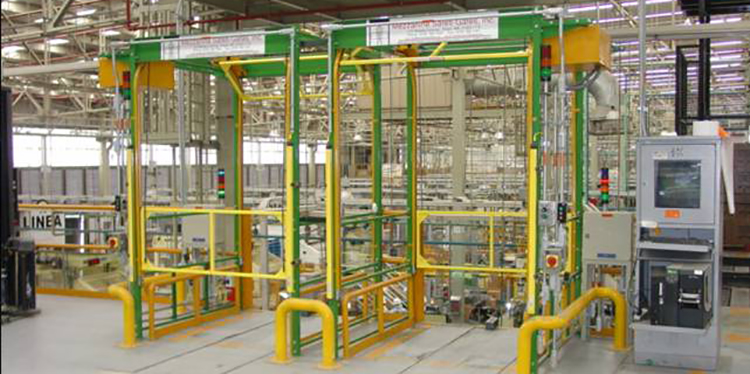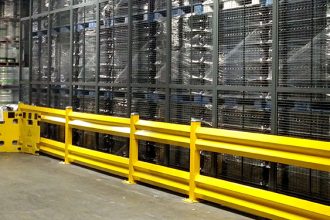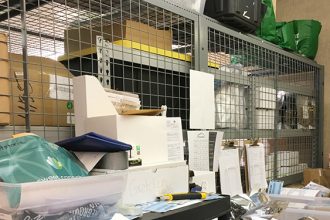Guard These Areas Above The Warehouse Floor To Protect Personnel

To increase the amount of usable space in an existing facility, operations often elect to look up — adding a variety of equipment, structures, and systems overhead. Yet, as we know from Sir Isaac Newton, what goes up, must come down. And whether the thing that comes down is a person falling from an elevated work platform, or a product tumbling off an overhead conveyor, the risk of injury to personnel is high. Fortunately, there are a variety of protective guarding solutions available to keep employees safe. Here, a tour of the different elevated areas in a facility that should be protected.
Elevated Work Platforms
Building elevated work platforms (also called mezzanines) within the four walls creates additional storage or work areas. For the safety of personnel working on these platforms, it is critical to install protective guarding in two places: the perimeter and at forklift pallet drop zones.
The outer edge, or perimeter, of an elevated work platform should be protected by guardrails that include a top rail, an intermediate rail and posts, as recommended by the Occupational Health and Safety Administration (OSHA) 1910.29: Fall Protection Systems and Falling Object Protection-Criteria and Practices, section 1910.29(k). The intermediate guardrails can be vertical, horizontal, or — for additional safety by preventing small items from falling through the openings — formed of a steel mesh or netting that closes off all gaps. The standard also includes specifications for kickplates mounted directly atop the flooring to prevent items from sliding off the edge.
Further, pallet drops — designated areas where forklifts place and remove pallet loads — should be protected in such a way that still permits access but prevents workers from falling off the edge. Some systems rely on removable guarding, chains, or single gates that swing open on hinges to one side or the other. However, a worker on the platform still has to approach the edge to remove, replace, open or close the device, which may be accidentally left open. Additionally, a single gate system may be held in the open position by a pallet, preventing it from being closed and exposing a worker who may be picking in proximity to the opening.
As an alternative, a dual gate system can be installed to create a safe, controlled access area. They are designed with two interconnected protective barriers — one at the ledge opening where pallets are placed, the other at the worker side of the platform — that open and close in tandem. That is, when one side of the gate is down, obstructing access to the pallet opening, the other side is up to permit access. This prevents a worker from entering the area when pallets are being loaded; conversely, it stops a forklift from placing pallets on the ledge when workers are present within the area. They can be operated manually, electrically or pneumatically with a push button, or triggered by sensors to automatically raise or lower as needed.
Multi-level Pallet Rack
Industrial steel storage rack systems reach several levels high to hold pallets of products. However, should the load not be properly contained with stretch-wrapping, shrink-wrapping, banding or another method, items may become loose and slide or topple off the rack. To prevent those items from falling and injuring personnel, accessories such as wire mesh barriers or flexible woven netting can be attached to the rack system. These barriers are most frequently installed in areas where rack is adjacent to walking aisles, or where loads are stored over work areas. The face of the aisles can also be covered with removable panels or netting that can be raised and lowered for access as needed.
Overhead Conveyors
To free up floorspace, some facilities utilize overhead conveyors to transport loads throughout the building. Yet, the conveyors themselves may lack sidewalls (or tall enough sidewalls) to keep product contained. Installing netting or steel mesh beneath these transport systems’ inclines, declines, and straight runs ensures that any cartons, totes or items that might fall off the sides are caught before they fall to the floor.
Pick Modules
There are two areas within pick modules — or platforms constructed from industrial steel pallet rack whose perimeters are protected by guardrail — that are frequently left unguarded: ledge openings for single pallet placement, and access openings to pallet flow lanes. Both swing these gaps can be secured with removable guardrails, chains, or single gate systems that operate on hinges to one side or the other. These methods still require personnel to be in close proximity to the edge to remove, open, or close them. For a safer approach that allows personnel to maintain a safe distance from the ledge, best practice is to secure the openings as follows:
- Pick module openings for single pallets are staged for picking (or where empty pallets and/or empty totes are stacked for removal) by fork trucks, a dual-gate system is recommended. This is similar to the systems discussed above used to create controlled access on elevated work platforms, which are constructed of two interconnected protective barriers. When one side of the gate is down, the pallet opening is blocked while the other side is raised, permitting access.
- Pick modules with openings for forklifts to feed pallets of product into flow lanes can be protected either with dual-gate systems, or with dual swinging gates, which are bolted into the rack’s upright columns on either side of the access point. These two-piece barriers swing only in one direction as the palletload is pushed through them; once it clears the gate, the two sides swing closed.
Additionally, some pick modules are constructed without decking underneath the pallet flow rails. Although the system designer may not believe personnel will need to access that area, if an item falls off a pallet and gets stuck, a worker may attempt to reach it and risk a fall. To eliminate this dangerous possibility, any openings in the floor under the pallet flow rails should be securely decked over.
Want more information about the different ways to protect employees from falls at heights? The members of the Protective Guarding Manufacturers Association (ProGMA) offer a list of Frequently Asked Questions (FAQs), here.



